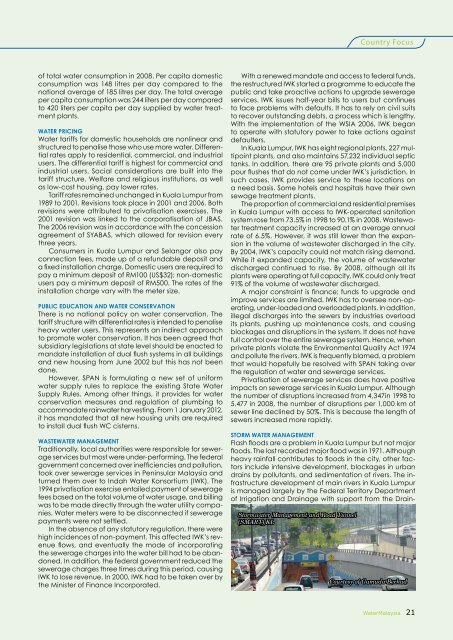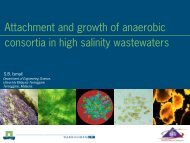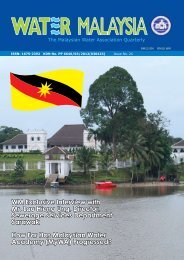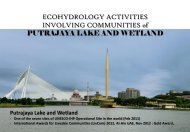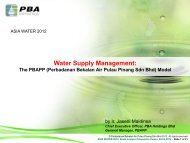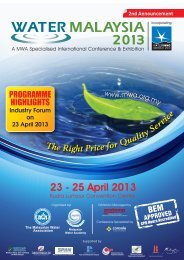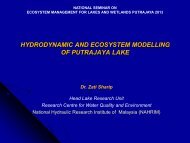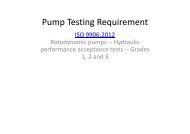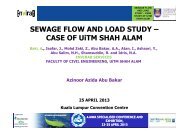Returning Malaysia's Rivers To L - Malaysian Water Association.
Returning Malaysia's Rivers To L - Malaysian Water Association.
Returning Malaysia's Rivers To L - Malaysian Water Association.
You also want an ePaper? Increase the reach of your titles
YUMPU automatically turns print PDFs into web optimized ePapers that Google loves.
Country Focus<br />
of total water consumption in 2008. Per capita domestic<br />
consumption was 148 litres per day compared to the<br />
national average of 185 litres per day. The total average<br />
per capita consumption was 244 liters per day compared<br />
to 420 liters per capita per day supplied by water treatment<br />
plants.<br />
<strong>Water</strong> Pricing<br />
<strong>Water</strong> tariffs for domestic households are nonlinear and<br />
structured to penalise those who use more water. Differential<br />
rates apply to residential, commercial, and industrial<br />
users. The differential tariff is highest for commercial and<br />
industrial users. Social considerations are built into the<br />
tariff structure. Welfare and religious institutions, as well<br />
as low-cost housing, pay lower rates.<br />
Tariff rates remained unchanged in Kuala Lumpur from<br />
1989 to 2001. Revisions took place in 2001 and 2006. Both<br />
revisions were attributed to privatisation exercises. The<br />
2001 revision was linked to the corporatisation of JBAS.<br />
The 2006 revision was in accordance with the concession<br />
agreement of SYABAS, which allowed for revision every<br />
three years.<br />
Consumers in Kuala Lumpur and Selangor also pay<br />
connection fees, made up of a refundable deposit and<br />
a fixed installation charge. Domestic users are required to<br />
pay a minimum deposit of RM100 (US$32); non-domestic<br />
users pay a minimum deposit of RM500. The rates of the<br />
installation charge vary with the meter size.<br />
Public Education and <strong>Water</strong> Conservation<br />
There is no national policy on water conservation. The<br />
tariff structure with differential rates is intended to penalise<br />
heavy water users. This represents an indirect approach<br />
to promote water conservation. It has been agreed that<br />
subsidiary legislations at state level should be enacted to<br />
mandate installation of dual flush systems in all buildings<br />
and new housing from June 2002 but this has not been<br />
done.<br />
However, SPAN is formulating a new set of uniform<br />
water supply rules to replace the existing State <strong>Water</strong><br />
Supply Rules. Among other things, it provides for water<br />
conservation measures and regulation of plumbing to<br />
accommodate rainwater harvesting. From 1 January 2012,<br />
it has mandated that all new housing units are required<br />
to install dual flush WC cisterns.<br />
Wastewater Management<br />
Traditionally, local authorities were responsible for sewerage<br />
services but most were under-performing. The federal<br />
government concerned over inefficiencies and pollution,<br />
took over sewerage services in Peninsular Malaysia and<br />
turned them over to Indah <strong>Water</strong> Konsortium (IWK). The<br />
1994 privatisation exercise entailed payment of sewerage<br />
fees based on the total volume of water usage, and billing<br />
was to be made directly through the water utility companies.<br />
<strong>Water</strong> meters were to be disconnected if sewerage<br />
payments were not settled.<br />
In the absence of any statutory regulation, there were<br />
high incidences of non-payment. This affected IWK’s revenue<br />
flows, and eventually the mode of incorporating<br />
the sewerage charges into the water bill had to be abandoned.<br />
In addition, the federal government reduced the<br />
sewerage charges three times during this period, causing<br />
IWK to lose revenue. In 2000, IWK had to be taken over by<br />
the Minister of Finance Incorporated.<br />
With a renewed mandate and access to federal funds,<br />
the restructured IWK started a programme to educate the<br />
public and take proactive actions to upgrade sewerage<br />
services. IWK issues half-year bills to users but continues<br />
to face problems with defaults. It has to rely on civil suits<br />
to recover outstanding debts, a process which is lengthy.<br />
With the implementation of the WSIA 2006, IWK began<br />
to operate with statutory power to take actions against<br />
defaulters.<br />
In Kuala Lumpur, IWK has eight regional plants, 227 multipoint<br />
plants, and also maintains 57,232 individual septic<br />
tanks. In addition, there are 95 private plants and 5,000<br />
pour flushes that do not come under IWK’s jurisdiction. In<br />
such cases, IWK provides service to these locations on<br />
a need basis. Some hotels and hospitals have their own<br />
sewage treatment plants.<br />
The proportion of commercial and residential premises<br />
in Kuala Lumpur with access to IWK-operated sanitation<br />
system rose from 73.5% in 1998 to 90.1% in 2008. Wastewater<br />
treatment capacity increased at an average annual<br />
rate of 6.5%. However, it was still lower than the expansion<br />
in the volume of wastewater discharged in the city.<br />
By 2004, IWK’s capacity could not match rising demand.<br />
While it expanded capacity, the volume of wastewater<br />
discharged continued to rise. By 2008, although all its<br />
plants were operating at full capacity, IWK could only treat<br />
91% of the volume of wastewater discharged.<br />
A major constraint is finance; funds to upgrade and<br />
improve services are limited. IWK has to oversee non-operating,<br />
under-loaded and overloaded plants. In addition,<br />
illegal discharges into the sewers by industries overload<br />
its plants, pushing up maintenance costs, and causing<br />
blockages and disruptions in the system. It does not have<br />
full control over the entire sewerage system. Hence, when<br />
private plants violate the Environmental Quality Act 1974<br />
and pollute the rivers, IWK is frequently blamed, a problem<br />
that would hopefully be resolved with SPAN taking over<br />
the regulation of water and sewerage services.<br />
Privatisation of sewerage services does have positive<br />
impacts on sewerage services in Kuala Lumpur. Although<br />
the number of disruptions increased from 4,347in 1998 to<br />
5,477 in 2008, the number of disruptions per 1,000 km of<br />
sewer line declined by 50%. This is because the length of<br />
sewers increased more rapidly.<br />
Storm water Management<br />
Flash floods are a problem in Kuala Lumpur but not major<br />
floods. The last recorded major flood was in 1971. Although<br />
heavy rainfall contributes to floods in the city, other factors<br />
include intensive development, blockages in urban<br />
drains by pollutants, and sedimentation of rivers. The infrastructure<br />
development of main rivers in Kuala Lumpur<br />
is managed largely by the Federal Territory Department<br />
of Irrigation and Drainage with support from the Drain-<br />
Stormwater Management and Road Tunnel<br />
(SMART),KL<br />
Courtesy of Gamuda Berhad<br />
<strong>Water</strong>Malaysia 21


